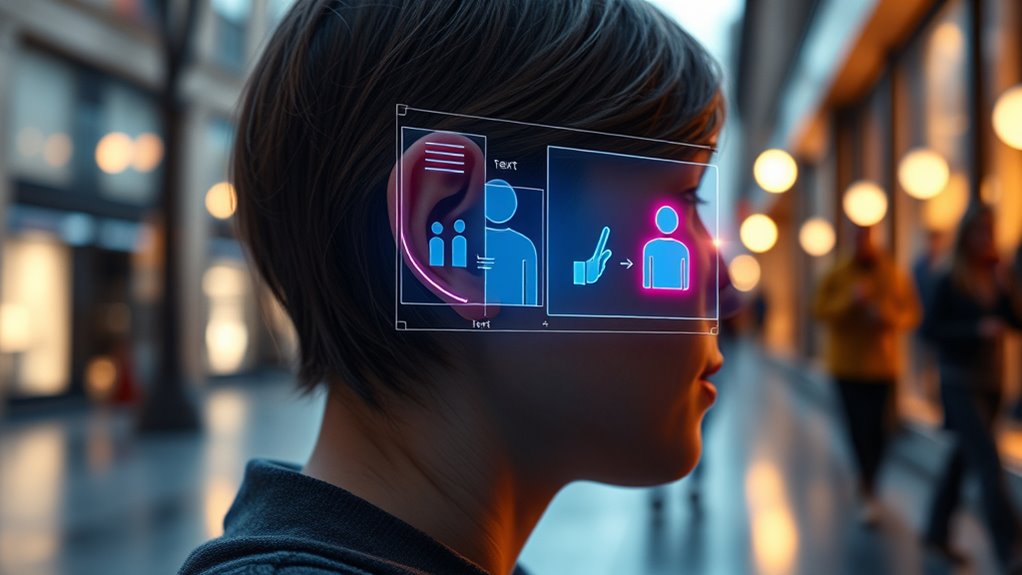Generative AI assistants considerably enhance accessibility by offering natural, intuitive interactions tailored to your needs. They utilize voice recognition technology to understand your speech and convert text to speech for easy listening. These tools help break down barriers for those with visual impairments or mobility challenges, promoting independence. As they adapt to your speech patterns over time, they become even more personalized. Keep exploring to discover how these innovations can transform your digital experience.
Key Takeaways
- Generative AI assistants utilize voice recognition and text-to-speech to facilitate natural, accessible interactions for users with disabilities.
- They enable seamless communication and device control through speech, reducing barriers for mobility and visual impairments.
- AI-driven personalization adapts to diverse speech patterns, improving accuracy and inclusivity for users worldwide.
- Integration of these technologies supports multitasking and information access, promoting independence for users with disabilities.
- Continuous advancements enhance recognition and responsiveness, fostering more equitable and user-friendly digital environments.

Generative AI assistants are transforming accessibility by providing personalized support that adapts to individual needs. One of the most impactful ways they do this is through advanced voice recognition technology. When you speak to an AI assistant, it listens carefully, accurately transcribing your words in real time. This ability to understand natural language means you can interact more comfortably and naturally, whether you’re steering your device, controlling smart home features, or seeking information. Voice recognition removes barriers for those with mobility challenges or difficulties using traditional input methods, making digital interactions more intuitive and accessible. It’s like having a conversation with a person who truly understands you, empowering you to perform tasks efficiently without needing complex commands or physical input.
AI assistants enhance accessibility through natural voice recognition, enabling easier, more intuitive interactions for everyone.
In addition to voice recognition, text to speech capabilities considerably enhance accessibility. When an AI assistant converts written content into spoken words, it opens up a world of information for people with visual impairments or reading difficulties. You can listen to articles, emails, or instructions without straining your eyes or struggling to read small fonts. The quality of text to speech has improved dramatically, providing natural-sounding voices that make listening feel more human and less robotic. This feature guarantees you stay informed and connected, regardless of your ability to read or see the screen. It’s especially helpful during multitasking or when you’re on the go, turning your device into a reliable auditory companion.
These AI-driven features work together seamlessly to create a more inclusive experience. For example, you can speak your commands, and the assistant responds with clear, articulate speech, making interactions feel fluid and effortless. This dynamic helps reduce frustration and increases independence, allowing you to accomplish more without relying heavily on others. Whether it’s setting reminders, steering apps, or accessing complex information, the combination of voice recognition and text to speech makes technology more accessible and user-friendly. Additionally, ongoing advancements in speech pattern recognition help AI adapt to diverse accents and speech styles, further enhancing inclusivity.
As these AI tools continue to evolve, their ability to recognize diverse accents and adapt to different speech patterns improves, further broadening accessibility. They learn from your usage, becoming more accurate and personalized over time. This ongoing development means you’ll experience fewer misunderstandings and more reliable support. In essence, generative AI assistants are breaking down barriers, giving you greater control and freedom when interacting with technology. Their intelligent integration of voice recognition and text to speech isn’t just about convenience — it’s about creating inclusive digital environments where everyone can participate fully.
Frequently Asked Questions
How Do Generative AI Assistants Ensure User Privacy?
You can trust that generative AI assistants protect your privacy through robust safeguards like data encryption, which secures your information during transmission and storage. They also implement privacy safeguards such as strict access controls and anonymization techniques to prevent unauthorized use of your data. These measures make certain your personal details stay confidential, giving you confidence that your interactions remain private and secure while using AI assistants.
Can AI Assistants Adapt to Individual Accessibility Needs?
Yes, AI assistants can adapt to your individual accessibility needs by learning from your interactions. They face personalization challenges, such as accurately understanding your specific preferences and requirements. Cultural considerations also play a role, ensuring the assistant respects your background. By continually refining their responses, they provide more tailored support, helping you navigate tasks comfortably and effectively. This adaptive approach enhances accessibility and makes technology more inclusive.
What Are the Limitations of Current AI Accessibility Tools?
You might find that current AI accessibility tools have limitations, especially in speech recognition and emotion detection. They may struggle with accents, background noise, or complex language, reducing accuracy. Emotion detection isn’t always reliable, sometimes misinterpreting feelings or missing subtle cues. These tools still need improvements to handle diverse users effectively, and they might not fully adapt to your unique needs, which can limit their usefulness in real-world situations.
How Do AI Assistants Handle Sensitive or Complex Information?
You might be surprised how AI assistants handle sensitive or complex info—they rely on emotional intelligence and contextual understanding to respond appropriately. When you share delicate details, they analyze tone and context to avoid missteps, but they aren’t perfect. You should still be cautious, as AI may miss nuances or inadvertently share info. Trust that ongoing improvements aim to make them more sensitive and context-aware, but always review responses carefully.
What Future Advancements Are Anticipated in AI for Accessibility?
You can expect AI for accessibility to become more personalized and intuitive, enhancing inclusivity for everyone. As AI ethics guides development, these tools will better respect user privacy and promote fairness. Digital literacy will also improve, helping you navigate AI features confidently. Future advancements include smarter speech recognition, adaptive interfaces, and more seamless integration, making technology more accessible and empowering you to overcome barriers with ease.
Conclusion
Imagine having a generative AI assistant that’s so powerful, it practically becomes your superpower, transforming your accessibility experience overnight. It’s like having a personal superhero by your side, breaking down every barrier and opening up a world of possibilities you never thought possible. With these tools, you’re not just overcoming challenges—you’re leaping over mountains, flying through obstacles, and redefining what’s achievable. The future of accessibility is here, and it’s more incredible than you ever imagined!











